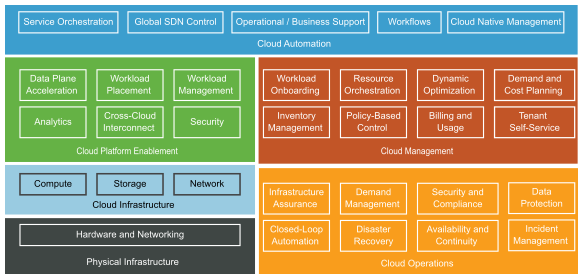Cloud infrastructure-based computing is the next-generation standard in modernizing the CSP networks as they evolve to 5G architectures, services, and agile delivery. The shared infrastructure with complete softwarization of network functions and applications provide greater advantages in cost, performance, and agility.
The modernization of the CSP infrastructure requires a complex ecosystem of solutions and functions delivering to a pre-set business and operating model. The cloud infrastructure modernization changes not only the business model in service agility and metered revenue models, but also challenges the silo operating model. The following figure shows the conceptual view of various domains, capabilities, and their interactions that require consideration in the modernization of networks and business and operational models.

Cloud Automation
Centralizes the overall service management functions such as service definitions, composition, onboarding, life cycle management, and support. The Cloud Automation domain hosts functions such as an NFV Orchestrator (NFVO) that is responsible for service blueprinting, chaining, and orchestration across multiple cloud infrastructure environments. Besides NFVO, the global SDN control functions are responsible for stitching and managing physical and overlay networks for cross-site services. Real-time performance monitoring can be integrated into the SDN functions to dynamically optimize network configurations, routes, capacity, and so on.
The successful cloud automation strategy implies full programmability across other functions.
Cloud Platform Enablement
Extends a set of platform capabilities from the cloud infrastructure to cloud automation, so VNFs, VNF managers, and other core components can leverage. Examples of enablement capabilities include:
Analytics to ingest VNF metrics that can be correlated with infrastructure metrics for smarter context and insights.
Workload placement to determine the right location for a workload depending on available resources, class of resources, and feature capabilities such as data intensive acceleration.
Workload acceleration using DPDK and SR-IOV for data intensive VNFs.
Security for network, data, and workloads.
Cloud Management
Cloud Management plays a critical role across many different dimensions. More fundamentally, it provides a templated and prescriptive workload management capabilities that the automation layer can use to program and orchestrate service on-demand and with agility. Service onboarding models can be turned into fully zero-touch provisioning and exposed to tenants through a self-service portal. Business models such as metered billing can be enabled as a catalog of services and tariffs.
After the services and workloads are onboarded, the cloud management functions must also ensure dynamic optimization such as workload rebalancing and capacity growth or shrink to maintain agreed SLAs. Such optimizations must integrate with the cloud operations domain for real-time usage and performance intelligence. Policies, including platform awareness, NUMA affinity, host affinity, restart-sequences, are necessary for efficient optimization.
Cloud Operations
Ensures that the operational policies and SLAs are met by continuous data collection, correlation, and analytics. Infrastructure assurance is a key component of this Cloud Operations domain. Intelligence can be tied into a closed-loop workflow that can be integrated in the automation domain for proactive issue avoidance, for example, triggering a trouble ticket incident management system.
Also, other functions for day 2 operations such as demand and capacity planning, security and compliance, high availability, and disaster recovery are necessary to ensure availability and integrity across the cloud infrastructure environments.
Cloud Infrastructure
The core virtualization domain providing resource abstraction for compute, storage, and networking and their orchestration through a VIM to allocate, control, and isolate with full multi-tenancy and platform-awareness.